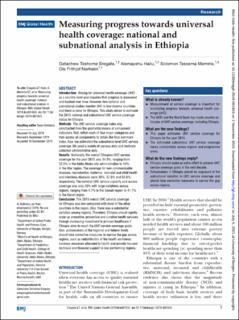| dc.contributor.author | Eregata, Getachew Teshome | |
| dc.contributor.author | Hailu, Alemayehu | |
| dc.contributor.author | Memirie, Solomon Tessema | |
| dc.contributor.author | Norheim, Ole Frithjof | |
| dc.date.accessioned | 2021-07-06T11:04:55Z | |
| dc.date.available | 2021-07-06T11:04:55Z | |
| dc.date.created | 2020-01-31T17:34:11Z | |
| dc.date.issued | 2019 | |
| dc.identifier.issn | 2059-7908 | |
| dc.identifier.uri | https://hdl.handle.net/11250/2763553 | |
| dc.description.abstract | Introduction: Aiming for universal health coverage (UHC) as a country-level goal requires that progress is measured and tracked over time. However, few national and subnational studies monitor UHC in low-income countries and there is none for Ethiopia. This study aimed to estimate the 2015 national and subnational UHC service coverage status for Ethiopia.
Methods: The UHC service coverage index was constructed from the geometric means of component indicators: first, within each of four major categories and then across all components to obtain the final summary index. Also, we estimated the subnational level UHC service coverage. We used a variety of surveys data and routinely collected administrative data.
Results: Nationally, the overall Ethiopian UHC service coverage for the year 2015 was 34.3%, ranging from 52.2% in the Addis Ababa city administration to 10% in the Afar region. The coverage for non-communicable diseases, reproductive, maternal, neonatal and child health and infectious diseases were 35%, 37.5% and 52.8%, respectively. The national UHC service capacity and access coverage was only 20% with large variations across regions, ranging from 3.7% in the Somali region to 41.1% in the Harari region.
Conclusion: The 2015 overall UHC service coverage for Ethiopia was low compared with most of the other countries in the region. Also, there was a substantial variation among regions. Therefore, Ethiopia should rapidly scale up promotive, preventive and curative health services through increasing investment in primary healthcare if Ethiopia aims to reach the UHC service coverage goals. Also, policymakers at the regional and federal levels should take corrective measures to narrow the gap across regions, such as redistribution of the health workforce, increase resources allocated to health and provide focused technical and financial support to low-performing regions. | en_US |
| dc.language.iso | eng | en_US |
| dc.publisher | BMJ | en_US |
| dc.rights | Navngivelse 4.0 Internasjonal | * |
| dc.rights.uri | http://creativecommons.org/licenses/by/4.0/deed.no | * |
| dc.title | Measuring progress towards universal health coverage: National and subnational analysis in Ethiopia | en_US |
| dc.type | Journal article | en_US |
| dc.type | Peer reviewed | en_US |
| dc.description.version | publishedVersion | en_US |
| dc.rights.holder | Copyright the authors 2019 | en_US |
| dc.source.articlenumber | e001843 | en_US |
| cristin.ispublished | true | |
| cristin.fulltext | original | |
| cristin.fulltext | original | |
| cristin.qualitycode | 1 | |
| dc.identifier.doi | 10.1136/bmjgh-2019-001843 | |
| dc.identifier.cristin | 1788938 | |
| dc.source.journal | BMJ Global Health | en_US |
| dc.identifier.citation | BMJ Global Health. 2019, 4 (6), e001843. | en_US |
| dc.source.volume | 4 | en_US |
| dc.source.issue | 6 | en_US |

